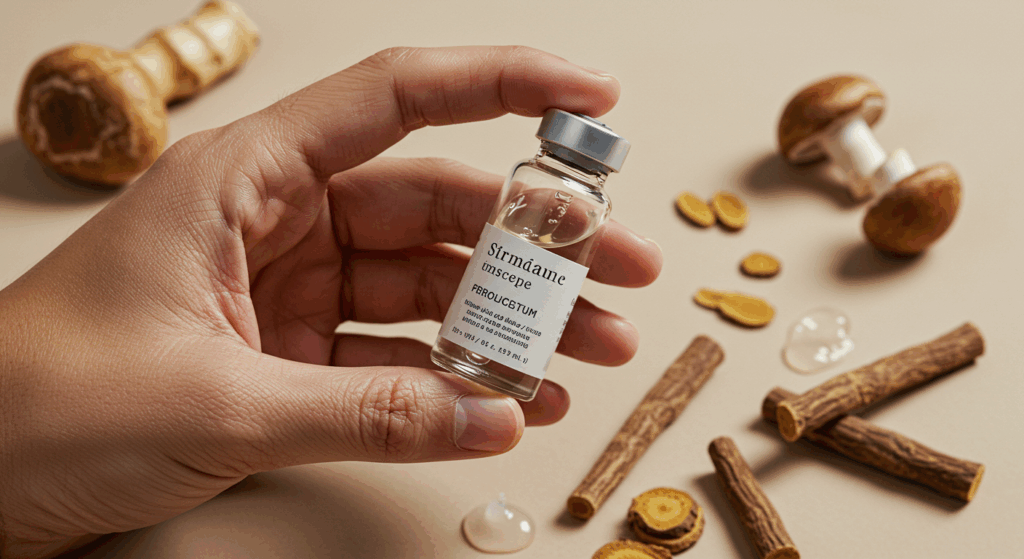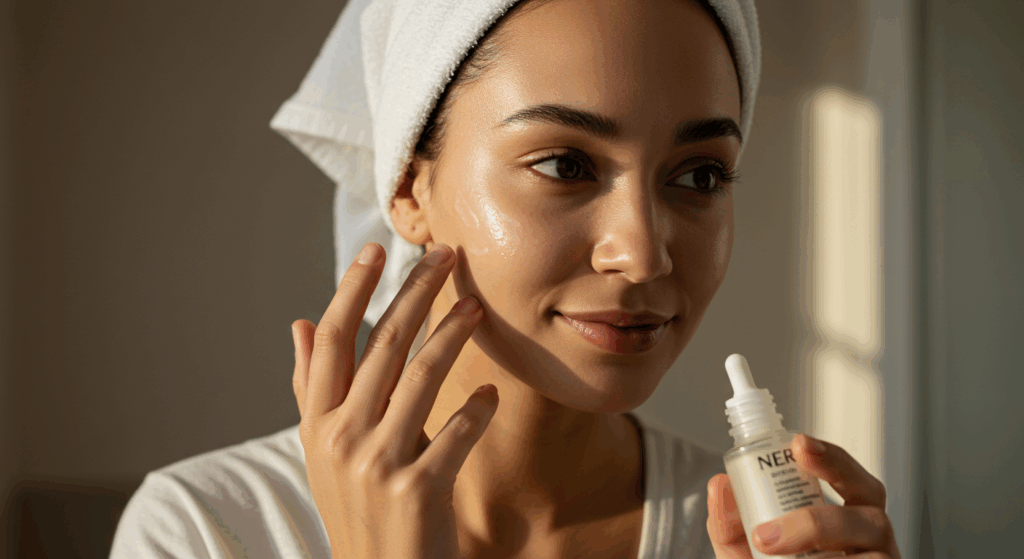هل تعانين من بقع الكلف العنيدة التي لا تزول؟ طبيب امراض جلدية بخبرة تزيد عن عقد في علاج اضطرابات فرط التصبغ، رأيتُ عددًا لا يُحصى من المرضى يُحسّنون بشرتهم بالعلاجات الحمضية المناسبة. في هذا الدليل الشامل لعام ٢٠٢٥، نتعمق في أفضل الأحماض لعلاج الكلف، نستكشف كيفية عملها، وأيها الأكثر فعالية، وكيفية دمجها بأمان في روتين العناية بالبشرة للحصول على نتائج دائمة.
يصيب الكلف ملايين الأشخاص حول العالم، وغالبًا ما يكون ناتجًا عن تغيرات هرمونية أو التعرض لأشعة الشمس أو عوامل وراثية. ورغم صعوبة علاجه، إلا أن الأحماض المُوجهة قادرة على تثبيط إنتاج الميلانين، وتعزيز تجدد الخلايا، وتفتيح البقع الداكنة بفعالية. سواء كنت تعاني من كلف الوجه أو تغير لون الجسم، فإن فهم الأساس العلمي لهذه المكونات الفعالة هو مفتاح الحصول على بشرة متجانسة اللون دون تهيج.

فهم الكلف: الأسباب والأعراض وأهمية الأحماض
الكلف حالة جلدية شائعة تتميز ببقع بنية أو رمادية مائلة للبني، تظهر عادةً على الوجه. وهو أكثر شيوعًا لدى النساء، خاصةً أثناء الحمل أو مع العلاجات الهرمونية، ولكنه قد يُصيب الرجال أيضًا. لم يُفهم السبب الدقيق تمامًا، ولكن عوامل مثل الأشعة فوق البنفسجية والالتهابات والتقلبات الهرمونية تلعب دورًا مهمًا.
تشمل الأعراض مناطق متناظرة من فرط التصبغ على الخدين والجبهة والشفة العليا والذقن. وعلى عكس فرط التصبغ التالي للالتهاب، غالبًا ما يتكرر الكلف دون علاج مناسب. لمزيد من المعلومات حول أساسيات الكلف، يُرجى الاطلاع على دليلنا المفصل. دليل الكلف.
العلم وراء استخدام الأحماض في علاج الكلف
تعمل الأحماض على تقشير سطح البشرة، وتثبيط إنزيم التيروزيناز (الإنزيم المسؤول عن إنتاج الميلانين)، وتعزيز الكولاجين لتحسين ملمس البشرة. في عام ٢٠٢٥، ومع التطورات في تركيبتها، ستصبح هذه الأحماض ألطف وأكثر فعالية، مما يقلل من فترة التعافي ويعزز الفعالية إلى أقصى حد. وتخترق أحماض الهيدروكسي، على وجه الخصوص، البشرة لاستهداف الخلايا الصبغية مباشرةً.
تشمل الفوائد الرئيسية زوالًا أسرع للبقع، وتقليل تكرارها، وتعزيز امتصاص عوامل التفتيح مثل فيتامين سي. مع ذلك، يعتمد اختيار الحمض المناسب على نوع بشرتكِ وشدتها وقدرتها على التحمل. استشيري دائمًا طبيب أمراض جلدية لتجنب فرط التصبغ التالي للالتهاب (PIH) الناتج عن سوء الاستخدام.

أفضل الأحماض لعلاج الكلف في عام ٢٠٢٥: تحليل شامل
عندما يتعلق الأمر بـ أفضل الأحماض لعلاج الكلفيبرز العديد منها بناءً على الأدلة السريرية ونتائج المرضى. سنستكشف آلية عمل كل منها، وفعاليتها، ونصائح الاستخدام، والآثار الجانبية المحتملة. تذكر، الاستمرارية هي الأساس، فغالبًا ما تظهر النتائج بعد 4-8 أسابيع من الاستخدام المنتظم.
1. حمض الترانيكساميك: المعيار الذهبي لعلاج الكلف العنيد
أحدث حمض الترانيكساميك (TXA) ثورةً في علاج الكلف منذ اعتماده في طب الأمراض الجلدية في أوائل الألفية الثانية. وهو في الأصل دواء مضاد لتحلل الفيبرين، يثبط TXA البلازمين، مما يقلل من العوامل الوعائية التي تساهم في تكوين الميلانين. أظهرت دراسات أُجريت عام 2025 تحسنًا يصل إلى 70% في درجات شدة الكلف باستخدام تركيبات 3-5% الموضعية.
يُفضّل استخدامه لعلاج: كلف الوجه المتوسط إلى الشديد، وخاصةً الكلف الهرموني. لطيف على البشرة الحساسة، مع احتمالية تهيج منخفضة. يُستخدم مرتين إلى ثلاث مرات أسبوعيًا ليلًا، ثم يُوضع مرطب. يُمزج مع واقي الشمس للحصول على أفضل النتائج، فالتعرض للأشعة فوق البنفسجية قد يُبطل مفعوله.
الإيجابيات: غير مُقشّر، آمن لجميع ألوان البشرة، آثار جانبية ضئيلة. السلبيات: نتائج أبطأ من المقشرات الأقوى؛ سعر الأمصال عالية الجودة مرتفع.
2. حمض الأزيليك: مضاد قوي للالتهابات للبشرة الحساسة
حمض الأزيليك، المُستخلص من الحبوب، مُتعدد الاستخدامات، إذ يُكافح الكلف عن طريق تثبيط التيروزيناز وإظهار خصائص مُضادة للبكتيريا. بتركيزات 15-20%، يُنافس الهيدروكينون، ولكن دون خطر ارتداد التصبغ. وقد أكدت التحليلات التلوية الحديثة لعام 2025 فعاليته في تقليل مساحة الكلف ومؤشر شدته (MASI) بمقدار 40-60%.
مناسب لـ: الكلف الالتهابي أو البشرة المعرضة لحب الشباب. آمن أثناء الحمل، مما يجعله مثاليًا للأمهات الحوامل. ابدئي باستخدام 10% مرتين يوميًا لزيادة تحمل البشرة. كما أنه يُوحد لون البشرة ويُقلل الاحمرار، مما يُعالج العديد من مشاكل البشرة.
- نصيحة للتطبيق: امزجيه مع مصل مرطب لمنع الجفاف.
- شهادة: مدعومة بتجارب عشوائية تظهر نتائج مماثلة لـ 4% هيدروكينون.
3. حمض الجليكوليك: خبير تقشير للبقع السطحية
حمض الجليكوليك، وهو حمض ألفا هيدروكسي (AHA) مستخلص من قصب السكر، يتغلغل بعمق بفضل صغر حجمه الجزيئي. يُسرّع هذا الحمض تجديد الخلايا، مُشتّتًا بذلك مجموعات الميلانين، مما يُضفي على البشرة إشراقة. في عام ٢٠٢٥، تُعدّ الأمصال اليومية منخفضة التركيز (٥-١٠١TP٣T) شائعة الاستخدام للعناية بالبشرة بعد التقشير.
| تركيز | تردد الاستخدام | النتائج المتوقعة |
|---|---|---|
| 5-8% | يوميا (مساءً) | بهتان خفيف في 4 أسابيع |
| 10-15% | 2-3 مرات في الأسبوع | تفتيح ملحوظ في غضون 6-8 أسابيع |
| 20%+ (تقشير) | للمحترفين فقط | انخفاض كبير في 1-3 جلسات |
الأفضل لـ: الكلف الجلدي المتضرر من الشمس. تجنبيه إذا كانت بشرتك حساسة جدًا، فقد يسبب حرقة. استخدميه مع مضادات الأكسدة مثل النياسيناميد لتهدئة البشرة.
4. حمض الكوجيك: مُفتِّح طبيعي من الفطريات
حمض الكوجيك، الذي تُنتجه بعض الفطريات، هو مثبط قوي للتيروزيناز، وهو عنصر أساسي في منتجات العناية بالبشرة الآسيوية. بتركيز 1-4%، يُخفف الكلف بفعالية دون تقشير قاسٍ. غالبًا ما تُمزج تركيبات 2025 مع مستخلص عرق السوس لتعزيز ثباته وفعاليته.
الأفضل لـ: الكلف الخفيف أو كعلاج إضافي. يُتحمل جيدًا، ولكنه قد يتأكسد ويتحول إلى اللون الأصفر - يُحفظ في زجاجات داكنة. يُستخدم تحت مرطب البشرة لمنع التهيج.
للحصول على رؤى حول ما إذا كان ما هو الحمض الأفضل للكلف؟، بما في ذلك حمض الكوجيك، قم بزيارة مقالتنا المخصصة.
5. حمض اللاكتيك: حمض ألفا هيدروكسي لطيف على البشرة الجافة
جزيئاته الأكبر تجعل حمض اللاكتيك أخف من حمض الجليكوليك، وهو مثالي للمبتدئين أو للبشرة الجافة. يُرطب البشرة أثناء تقشيرها، مما يُحسّن وظيفة حاجز البشرة ويُقلل من التصبغ. تُظهر البيانات السريرية لعام ٢٠٢٥ تحسنًا في مؤشر MASI بمقدار ٢٠-٣٠١TP3T مع استخدام ٥-١٠١TP3T.
الأفضل لـ: الكلف المختلط والجفاف. يُستخدم كتونر أو سيروم، ٣-٤ مرات أسبوعيًا. كما أنه رائع لإشراقة البشرة بشكل عام.
٦. حمض الماندليك: خيار مضاد للبكتيريا لعلاج الكلف المرتبط بحب الشباب
يُقدّم حمض الماندليك، المُستخرج من اللوز المر، فوائد مضادة للميكروبات واسعة النطاق، مما يجعله مناسبًا لعلاج الكلف المُتفاقم بسبب حب الشباب. يضمن حجمه الكبير امتصاصًا أبطأ، مما يُقلل من التهيج. وقد أظهرت دراسات أُجريت عام ٢٠٢٥ دوره في الوقاية من فرط تنسج الجلد الناتج عن حب الشباب.
الأفضل للبشرة الدهنية أو المختلطة. استخدمي 5-10% ليلاً، ثم استخدمي واقي شمس بعامل حماية 50+ يوميًا.
7. حمض الساليسيليك: لعلاج الكلف الكوميدوني
حمض الساليسيليك، وهو حمض بيتا هيدروكسي (BHA)، يفتح المسام ويقشر البشرة، مستهدفًا الكلف المرتبط بالبشرة المسدودة. بتركيز 1-2%، فهو فعال دون جفاف مفرط.
الأفضل لحالات تداخل حب الشباب والكلف. يُنصح بالاقتصار على الاستخدام مساءً لتجنب التحسس للضوء.
اكتشف المزيد على خيارات علاج الكلف والتي قد تشمل هذه الأحماض.
كيفية دمج الأحماض في روتين العناية بالبشرة المصابة بالكلف بأمان
يتطلب استخدام الأحماض الصبر لبناء القدرة على التحمل. ابدأ بكمية قليلة وبطيئة: اختبرها على منطقة صغيرة من الجزء الداخلي من ذراعك لمدة 48 ساعة. استخدمها ليلاً، واتبعها دائمًا بواقي شمس واسع الطيف (SPF 50+ PA++++) خلال النهار - فالحماية من الشمس ضرورية لعلاج الكلف.
روتين خطوة بخطوة لاستخدام الحمض
- تطهير: منظف لطيف وغير رغوي لإزالة الشوائب.
- نغمة: مقشر خفيف اختياري إذا لم تستخدم الحمض كخطوة أولى.
- تطبيق الحمض: الأمصال أو التقشير حسب تعليمات المنتج.
- يعامل: استخدميه مع النياسيناميد أو فيتامين سي للحصول على نتيجة متناغمة.
- ترطيب: كريم إصلاح الحاجز للحفاظ على الترطيب.
- يحمي: يتم إعادة وضع واقي الشمس صباحًا كل ساعتين.
راقبي أي احمرار أو حكة أو تقشير - علامات تستدعي تخفيف المنتج أو إيقافه مؤقتًا. يُنصح الحوامل بالالتزام بحمض الأزيليك أو حمض اللاكتيك. للحصول على إرشادات طبية، يُنصح بتقشير البشرة في العيادة باستخدام هذه الأحماض.
| نوع الحمض | ملاءمة نوع البشرة | الآثار الجانبية الشائعة | توصيات الاقتران |
|---|---|---|---|
| ترانيكساميك | جميع الأنواع | جفاف نادر | واقي الشمس، النياسيناميد |
| أزيلايك | حساسة، معرضة لحب الشباب | لسعة خفيفة | المرطبات والريتينويدات (أيام متبادلة) |
| حمض الجليكوليك | عادي إلى دهني | تهيج، حساسية الشمس | حمض الهيالورونيك ومضادات الأكسدة |
| كوجيك | الجميع، وخاصة العادلة | اصفرار، حساسية | فيتامين سي، عرق السوس |
| حمض اللاكتيك | جاف، ناضج | الحد الأدنى | الببتيدات والسيراميدات |
| ماندليك | دهني، حب الشباب | تهيج منخفض | بنزويل بيروكسيد |
| حمض الساليسيليك | زيتي، مزدحم | جفاف | مرطبات خالية من الزيوت |
تجنب الأخطاء الشائعة في العلاج بالأحماض
يؤدي الإفراط في الاستخدام إلى تلف حاجز البشرة، مما يؤدي إلى تفاقم التصبغ. لا تخلطي أحماض ألفا هيدروكسي/أحماض بيتا هيدروكسي القوية مع الريتينول في البداية. إذا استمر التهيج، فاستبدليه بتركيبات مُخففة. تابعي التقدم بالصور كل أسبوعين.
هل الكلف دائم؟ تعرّف على المزيد في مقالتنا هل الكلف دائم؟.
استراتيجيات متقدمة: الجمع بين الأحماض والعلاجات المهنية
للحصول على نتائج أفضل، يُنصح بدمج الأحماض المنزلية مع التدخلات السريرية. في عام ٢٠٢٥، ستظهر بروتوكولات مُخصصة قائمة على الاختبارات الجينية، مما يُحسّن اختيار الأحماض.
إجراءات داخل العيادة لتعزيز فعالية الحمض
التقشير الكيميائي: يُعزز التقشير متوسط العمق باستخدام حمض الجليكوليك أو حمض ثلاثي كلورو الأسيتيك (TCA) تأثير الأحماض الموضعية. يُتوقع تحسن بنسبة 20-50% لكل جلسة.
٢. الوخز بالإبر الدقيقة: يُعزز الأحماض ويُحفّز الإصلاح. آمن مع حمض الترانساميناسك لعلاج الكلف الوعائي.
3. العلاج بالليزر: تستهدف أشعة الليزر Q-switched الميلانين دون الإضرار بالجلد؛ يتم العلاج المسبق باستخدام الأزيليك لتقليل المخاطر.
4. حمض الترانيكساميك عن طريق الفم: في الحالات الشديدة، 250 ملغ مرتين يوميًا تحت الإشراف - تدعم إرشادات عام 2025 الاستخدام قصير المدى.
- نصيحة مشتركة: يؤدي استخدام الكوجيك الموضعي + حمض الترانسيكا + التقشير عن طريق الفم إلى تأثيرات تآزرية.
- ملاحظة السلامة: يجب عليك دائمًا الإبلاغ عن استخدام الأحماض لطبيب الأمراض الجلدية الخاص بك.
اكتشف أفضل مزيلات الكلف في دليلنا على ما هو افضل مزيل للكلف.
نمط الحياة والتدابير الوقائية
بالإضافة إلى الأحماض، تحكّم في العوامل المحفزة: استخدم واقيات الشمس المعدنية، وتجنّب الحرارة (كالساونا واليوغا الساخنة)، ووازن الهرمونات من خلال اتباع نظام غذائي أو علاج. الأطعمة الغنية بمضادات الأكسدة، مثل التوت، تدعم تجديد البشرة.
خاتمة
النقاط الرئيسية
- تعد أحماض الترانيكساميك والأزيليك من الخيارات الأفضل لعلاج الكلف بشكل آمن وفعال في عام 2025.
- تتميز الأحماض الجليكوليك واللاكتيك بقدرتها على التقشير لأنواع البشرة المختلفة، بينما يوفر الكوجيك تفتيحًا طبيعيًا.
- استخدم دائمًا الأحماض مع الحماية القوية من الشمس وابدأ ببطء لتجنب التهيج.
- يمكن للمجموعات المهنية مثل التقشير والليزر تسريع النتائج - استشر أخصائيًا.
الخطوات التالية
هل أنتِ مستعدة للتخلص من الكلف؟ احجزي موعدًا مع الدكتورة إبرو أوكياي في عيادتنا في أنطاليا للحصول على خطة علاج حمضية مُخصصة. ابدأي باختبار بسيط على منطقة صغيرة من بشرتكِ باستخدام أحد المنتجات المُوصى بها، وتابعي تقدمكِ. لون بشرتكِ مُوحد في انتظاركِ!
الأسئلة الشائعة
ما هو الحمض الأفضل لعلاج الكلف؟
يُعتبر حمض الترانيكساميك الخيار الأمثل لعلاج الكلف، نظرًا لقدرته على تثبيط إنتاج الميلانين، مع آثار جانبية ضئيلة. أما حمض الأزيليك، فهو ممتاز للبشرة الحساسة.
هل يمكن لحمض الكوجيك علاج الكلف؟
نعم، حمض الكوجيك فعال في علاج الكلف عن طريق تثبيط التيروزيناز. استخدم تركيزات 1-2% للحصول على أفضل النتائج، مع استخدام واقي الشمس.
كم من الوقت يستغرق الأحماض حتى تعمل على علاج الكلف؟
عادة ما يحدث التحسن المرئي في غضون 4-8 أسابيع مع الاستخدام المستمر، على الرغم من أن النتائج الكاملة قد تستغرق 3-6 أشهر.
هل الأحماض آمنة أثناء الحمل لعلاج الكلف؟
حمض الأزيليك وحمض اللاكتيك آمنان عمومًا؛ تجنب الرتينويدات وأحماض ألفا هيدروكسي عالية التركيز. استشر طبيبك.
ماذا لو كانت الأحماض تهيج بشرتي؟
خففيه بمرطب، قللي من تكرار الاستخدام، أو استخدمي خيارات ألطف مثل حمض الماندليك. توقفي في حال حدوث رد فعل تحسسي شديد.
هل يمكنني استخدام عدة أحماض لعلاج الكلف؟
نعم، ولكن بالتناوب بين الأيام لمنع التهيج - على سبيل المثال، حمض الترانساميناسك في الصباح، وحمض الجليكوليك في المساء.
هل حمض الترانيكساميك الفموي فعال لعلاج الكلف؟
نعم، يمكن لـ TXA عن طريق الفم لفترة قصيرة (250 ملغ مرتين يوميًا) أن يعزز العلاجات الموضعية، ولكن فقط تحت إشراف طبي.
كيف يؤثر التعرض لأشعة الشمس على علاجات الكلف الحمضية؟
تزيد الأشعة فوق البنفسجية من تفاقم الكلف وتقلل من فعالية الحمض؛ لذا فإن استخدام عامل حماية من الشمس SPF 50+ بشكل يومي أمر ضروري لمنع تكرار ظهوره.
بصفتها طبيبة جلدية رائدة في أنطاليا، تتخصص الدكتورة إبرو أوكياي في علاجات الكلف المتقدمة المصممة خصيصًا لبشرتك. احجزي استشارتك اليوم للحصول على نصائح الخبراء حول أفضل الأحماض التي تناسب احتياجاتك الخاصة.
